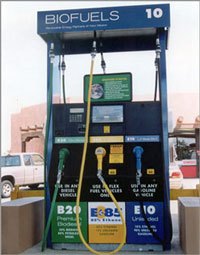Editorial: A Sober Look at Biofuels

I love my Accord. I love cornering so hard that the outer edges of my tires are always worn, despite good wheel alignment. I love gearing down with the stick, and feeling the surge as the VTEC spools up and hits the sweet spot. Love that sound! To be sure, it’s no Boxster, but it IS Salieri to the Boxster’s Mozart. I don’t want no stinkin’ hybrid. I’ll take my internal combustion straight, like my bourbon. I don’t want an EV. In my nightmares, Better Place has taken over, and I’m driving a podmobile with a short range and the slows. But the twin specters of global climate disruption and peak oil are a dark cloud that follows me wherever I drive. I believe that we must replace fossil fuels with efficiency measures and renewables with all due haste or civilization will crumble in this century.
According to New Scientist, the lower 48 could become uninhabitably hot and dry by 2100. And so I grasp at any hint of deux ex machina. Magic batteries with high energy density and fast charging? OK! Carbon sequestration (oh, please, oh please!). Biofuels? Bring ’em on! High energy density liquids from cellulosic crops grown on marginal lands, or from pools of algae growing in the desert sun, or from sugar cane. Some concepts would even produce petrol. Liquid gold . . .
Or pie in the sky. A major problem with most biofuels is that when wild land is converted to crops, there is a carbon debt, according to an article published in Science last year. That’s because the soil, and the plants and trees that grow thereon store an immense amount of carbon. It would take 17 years of sugarcane production on an acre of Brazilian Cerrado, a type of savannah, to mitigate as much carbon emission as that land naturally stores in the wild state. For the tropical peat lands that have been converted to palm oil plantations, the carbon debt is 420 years. Converting central US grasslands to corn for ethanol incurs a 93-year note.
Nor can you simply convert croplands previously used for food to fuel, because if you do, it will become necessary to plow new land somewhere in the world to replace that food, incurring more debt, according to a second article in Science published concurrently.
Even growing sugarcane on the Brazilian Cerrado, where the carbon debt is a short 17 years is potentially a problem not a solution. The reason is simple. Experts anticipate tipping points in global climate disruption. One possibility: the earth’s reflectivity influences its heat balance. As arctic ice melts, exposing dark ocean, the earth absorbs more heat from the sun, hastening warming.
If the warming reaches a point where the melting of the permafrost begins to release the massive quantities of methane stored within, that gas, which has more than 20 times the insulating power of carbon dioxide, could make warming irreversibly worse. There are many other potential tipping points. And experts fear that we could begin reaching them within the next two decades.
To be sure, certain cellulosic crops such as switchgrasses could sequester carbon in the soil while being harvested for biofuels, although we still haven’t figured out how to break the cellulose down in an efficient manner. Algae production in closed artificial ponds in, say, the desert southwest may eventually produce truly ample feedstock per acre, according to some experts. And waste to energy could well become a bountiful source of liquid fuels. But all this is pretty speculative at the moment, and the inevitable question arises: how much might we produce?
Perhaps the most optimistic of respectable studies on biofuels’ potential in the US, “Growing Energy,” comes from the Natural Resources Defense Council. The study suggests that it might be possible by 2050 to shrink US demand for liquid fuels to the point where the various sources could almost meet the demand while neither displacing food production nor boosting crop acreage.
The problem is that when market forces come into play, it will become extremely hard to ensure that biofuels will be grown in a way that won’t add onerously to carbon debt and global warming. An article in the 27 March 2008 issue of Time noted that deforestation “closely tracks” commodity prices on the Chicago Board of Trade—and that’s despite increased law enforcement in Brazil beginning early in the decade.
Even Nathanael Greene of the Natural Resources Defense Council, a coauthor of “Growing Energy” who professes optimism about biofuels, conceded on his blog that “. . . it is definitely possible . . . that the amount of truly low-carbon biofuels we can drive through real politics and real markets is much smaller than we would hope.”

I'm a freelance journalist covering science, medicine, and automobiles.
More by David C. Holzman
Latest Car Reviews
Read moreLatest Product Reviews
Read moreRecent Comments
- Ger65691276 I would never buy an electric car never in my lifetime I will gas is my way of going electric is not green email
- GregLocock Not as my primary vehicle no, although like all the rich people who are currently subsidised by poor people, I'd buy one as a runabout for town.
- Jalop1991 is this anything like a cheap high end German car?
- HotRod Not me personally, but yes - lower prices will dramatically increase the EV's appeal.
- Slavuta "the price isn’t terrible by current EV standards, starting at $47,200"Not terrible for a new Toyota model. But for a Vietnamese no-name, this is terrible.


































Comments
Join the conversation
Comparing climate prediction to economic prediction? You really believe that predicting that next July in the US will be warmer than last December was, is of the same order of reliability as predicting that the DOW next July will be higher than it was last December?